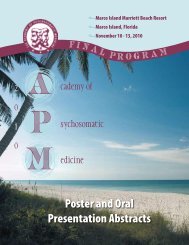Table of Contents - Academy of Psychosomatic Medicine
Table of Contents - Academy of Psychosomatic Medicine
Table of Contents - Academy of Psychosomatic Medicine
You also want an ePaper? Increase the reach of your titles
YUMPU automatically turns print PDFs into web optimized ePapers that Google loves.
linguistic pr<strong>of</strong>iciencies. Issues included the “organic-functional”<br />
dichotomy in the context <strong>of</strong> culture, end <strong>of</strong> life decisions<br />
across cultures, capacity determination in a cultural context,<br />
family communication patterns and the cultural aspects <strong>of</strong><br />
the doctor-patient relationship. Considerations <strong>of</strong> culture add<br />
to the complexity <strong>of</strong> the biopsychosocial formulation inherent<br />
in C-L psychiatry, in a way that is unique in the psychiatric<br />
training experience.<br />
References<br />
Fung K, et. Al. An integrative approach to cultural competence<br />
in the psychiatric curriculum, Academic Psychiatry,<br />
32:4 July-August 2008<br />
Weiss Roberts L, et al. When providers and patients come<br />
from different backgrounds: perceived value <strong>of</strong> additional<br />
training on ethical care practices. Transcultural Psychiatry,<br />
45(4) December 2008<br />
75. Accessible, Beneficial & Consistent<br />
Learning: The Beginning <strong>of</strong> Quality Care<br />
Presenting Author: Kristin Somers, MD<br />
Co-Authors: Pamela Netzel, MD, Kemuel Philbrick, MD,<br />
FAPM<br />
Purpose: An essential prerequisite for quality care in psychosomatic<br />
medicine is laying a foundation <strong>of</strong> effective<br />
teaching, practical clinical experience, and demonstrable<br />
competency during training. These elements may be difficult<br />
to forge when residents are supervised by rotating faculty,<br />
serve in diverse clinical settings, and rarely complete formal<br />
evaluations <strong>of</strong> their knowledge base. We describe the construction<br />
<strong>of</strong> a web-based curriculum for psychosomatic medicine<br />
that addresses these needs.<br />
Methods: An internal website was built with five principal<br />
components: 1) fundamental factual, scientific content on<br />
key topical areas arranged in user-friendly slideshow summaries<br />
and with links to relevant reference material; 2) resource<br />
material germane to the ‘art’ <strong>of</strong> consultation psychiatry,<br />
e.g., interviewing tips, frequently encountered personality<br />
traits and challenges; 3) selected advanced articles and<br />
resources for the returning senior resident and/or fellow, including<br />
material on teaching and evaluating; 4) selections<br />
from non-medical literature that provide a unique, affectivelyinformed,<br />
window on issues commonly encountered in psychosomatic<br />
medicine, e.g., the passage from Tolstoy’s Anna<br />
Karenina describing her feelings and thoughts prior to her<br />
suicide attempt; and, 5) case-vignettes and questions designed<br />
to aid the trainee in preparing for certification exams.<br />
Results: Trainees and faculty commonly rotate at irregular<br />
intervals and for variable durations to the consultation<br />
service; a well-ordered delineation <strong>of</strong> core topics appended<br />
by easily accessible, consistent didactic material frees the<br />
faculty and trainee to use available time to efficiently review<br />
the fundamentals <strong>of</strong> psychosomatic medicine. Whatever<br />
the level <strong>of</strong> training, educational needs are served by the<br />
breadth and depth <strong>of</strong> available material. Trainees who take<br />
initiative for self-assessment can gauge their progress using<br />
the board-style knowledge appraisal tools. Institutional<br />
s<strong>of</strong>tware options may vary; ideally, trainees will have access<br />
31<br />
to a personalized record that enables tracking which topical<br />
areas they have already covered.<br />
Conclusion: Construction <strong>of</strong> an easily accessed, systematic<br />
summary <strong>of</strong> essential knowledge augmented by learning<br />
tools that engage the trainee will facilitate ‘point-<strong>of</strong>-need’<br />
learning on psychosomatic medicine services and help ensure<br />
delivery <strong>of</strong> quality care.<br />
References: Novack DH: Realizing Engel’s vision: psychosomatic<br />
medicine and the education <strong>of</strong> physician-healers.<br />
<strong>Psychosomatic</strong> <strong>Medicine</strong>. 65(6):925-30, 2003 Nov-Dec.<br />
76. Constant Observation for Delirious<br />
Patients in the General Hospital: Allocation <strong>of</strong><br />
Resources and its Implications for Quality <strong>of</strong><br />
Care<br />
Presenting Author: Lisa Seyfried, MD<br />
Co-Author: Helen Kales, MD<br />
Background: A frequent clinical tension between psychiatric<br />
consultation-liaison (CL) and medical-surgical services is<br />
over the need for constant observation for delirious patients.<br />
Purpose: To identify patient characteristics contributing to<br />
the recommendation for constant observation <strong>of</strong> delirious patients<br />
in the general hospital.<br />
Methods: In response to an adverse event, we conducted<br />
a retrospective chart review <strong>of</strong> all consults to the CL service<br />
at the University <strong>of</strong> Michigan Hospital occurring during<br />
the month <strong>of</strong> the event. Using an electronic medical record<br />
search engine (EMERSE), we identified all patients diagnosed<br />
with delirium by the consult service. Information extracted<br />
from the charts was examined qualitatively to determine<br />
themes pertaining to the use <strong>of</strong> CO.<br />
Results: During the study month, the CL service saw 115<br />
new consults. Of those, 34 (30%) were diagnosed with delirium.<br />
Of those, the CL service specifically recommended<br />
CO for 11 patients (32% <strong>of</strong> delirious patients or 10% <strong>of</strong> total<br />
consults). Factors associated with CO were documented behavioural<br />
problems (such as pulling lines, getting out <strong>of</strong> bed,<br />
physical aggression, etc) and “agitation” in general. Factors<br />
associated with no recommendation for CO include features<br />
more consistent with hypoactive delirium. There was no<br />
documentation regarding the discontinuation <strong>of</strong> CO in any <strong>of</strong><br />
the 11 cases.<br />
Conclusion: Delirium is a major reason for psychiatric consults<br />
and a significant proportion <strong>of</strong> delirium consults may<br />
need constant observation due to hazardous behaviours.<br />
Liaison with medical-surgical services may be enhanced by<br />
informing such discussion with a clearer understanding <strong>of</strong><br />
the need for such services.



